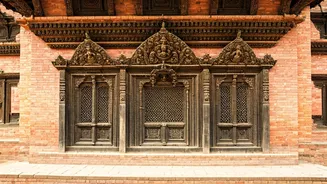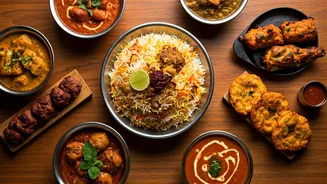Patan's Historical Heartbeat
Patan, also known as Lalitpur, stands as a testament to Nepal's rich cultural heritage. Its history is interwoven with the Malla dynasty, whose reign left
behind an array of architectural wonders and artistic legacies. The city’s core is centered around Patan Durbar Square, a UNESCO World Heritage site, which showcases exquisite Newari architecture. The intricate wood carvings, metalwork, and stone sculptures reflect the advanced craftsmanship of the era. The significance of Patan extends beyond its aesthetic appeal; it is a living museum, where traditions continue to thrive. Locals maintain ancient rituals, and traditional crafts are passed down through generations. The city’s narrow alleyways, filled with temples, stupas, and residences, evoke a sense of timelessness. Walking through Patan is like stepping into a different world where history, art, and community coexist harmoniously. The city provides a glimpse into a time when artistic expression flourished, leaving behind a treasure trove of cultural assets to be cherished for generations to come.
Durbar Square's Splendor
Patan Durbar Square is the undisputed centerpiece of the city, exhibiting remarkable architectural precision. The square's main structures include the Patan Museum, located in the former Malla palace, which houses a vast collection of religious art, bronze statues, and traditional artifacts. The Krishna Mandir, built entirely of stone, is one of the square's most striking temples, known for its intricate carvings depicting scenes from the Hindu epic Mahabharata. The Taleju Bhawani Temple and the Bhimsen Temple are also notable, each showcasing unique architectural styles and historical significance. The square isn't merely a cluster of buildings; it is a bustling hub where daily life intertwines with the city's past. Local vendors sell handicrafts, while religious ceremonies and festivals enliven the area, offering a rich cultural experience. The fusion of art, history, and communal life makes Patan Durbar Square a dynamic space. Exploring the square provides a vivid understanding of Nepal's cultural depth and the artistry of the Newar people. Every corner reveals a story, making each visit a new discovery.
Exploring Local Treasures
Beyond Durbar Square, Patan offers many hidden gems, contributing to its allure. The Golden Temple (Hiranyavarna Mahavihar), famed for its exquisite golden façade and intricate decorations, provides a serene retreat. The Kumbheshwor Temple, one of the oldest in the Kathmandu Valley, is known for its five roofs and sacred pond, which is a significant pilgrimage site. Throughout the city, you'll find numerous smaller temples, monasteries, and courtyards, each representing a unique aspect of Patan's cultural narrative. The network of winding alleys is an invitation to explore traditional Newari residences, local workshops, and craft shops. It's easy to come across artisans creating intricate wood carvings, metalwork, and pottery. These encounters offer an insight into Patan's artistic legacy. Interacting with local craftspeople and experiencing their traditional practices fosters a deeper understanding of the city's creative spirit. These encounters help visitors appreciate the continuous vitality of Patan's cultural identity. Every alleyway reveals new dimensions to the city, making Patan a place where every corner unveils a unique aspect of local life and artistic creativity.
Experiencing Local Life
Immersing yourself in the local way of life is a key aspect of any visit to Patan. Observe daily activities, such as early morning prayers, the preparation of traditional Newari dishes, and the lively interactions in local markets. Traditional Newari cuisine, known for its spices and flavors, is another key facet of the Patan experience. Dishes like *yomari*, *chatamari*, and *bara* are readily available in local eateries, offering visitors a delightful culinary journey. Exploring the city's small shops and bazaars gives an insight into daily existence. Local festivals and celebrations, often held in Durbar Square, add to the lively atmosphere, showcasing traditional dance, music, and religious rituals. Engage with local residents, learn a few Nepali phrases, and participate in cultural events to create a more profound and memorable experience. Patan’s welcoming atmosphere encourages visitors to discover the genuineness and warmth of its community. Engaging in local traditions offers unique opportunities to appreciate and learn the city's cultural depth. Through such engagement, Patan transitions from a place to see into a place to truly feel and experience.













